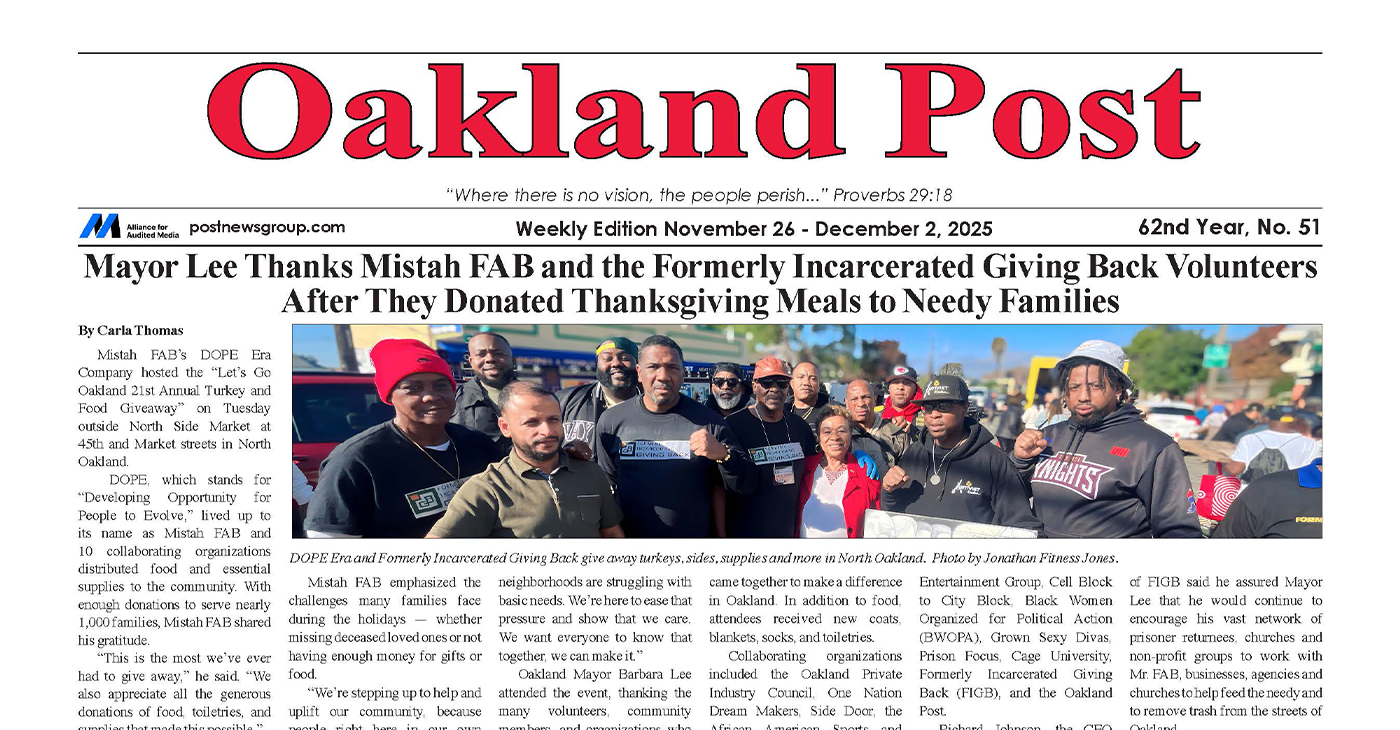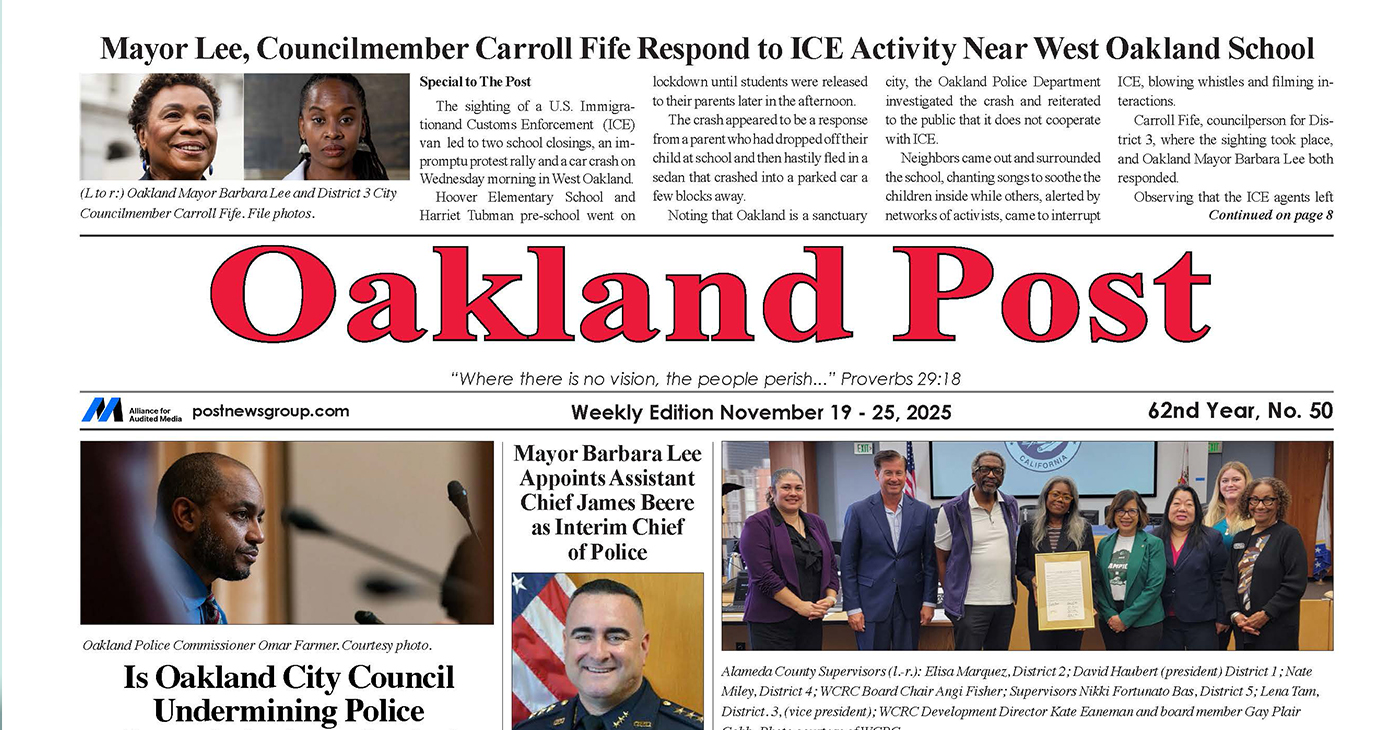Bay Area
Mayor Sheng Thao Speaks on Public Safety, Oakland-Vietnam Trade Opportunities
Oakland Mayor Sheng Thao, just back from a Vietnam trade mission, spoke at a press conference this week to discuss the results of her international meetings and also to address community concerns about crime in the city. She said she is “working day and night” to increase public safety: investing in violence prevention programs, seeking more funding to expand public safety resources, and collaborating with the governor to bring in the California Highway Patrol and Alameda County Sheriff’s Office.

By Ken Epstein
Oakland Mayor Sheng Thao, just back from a Vietnam trade mission, spoke at a press conference this week to discuss the results of her international meetings and also to address community concerns about crime in the city.
She said she is “working day and night” to increase public safety: investing in violence prevention programs, seeking more funding to expand public safety resources, and collaborating with the governor to bring in the California Highway Patrol and Alameda County Sheriff’s Office.
As the mayor of Oakland, she said, “I was able to call the governor directly, and this is now why we have the resources of CHP here in the City of Oakland.
Pointing out that the city now has the highest number of officers in uniform in the past three years, she said there is still work to be done to put the officers where they are needed most.
Thao also discussed the recent successful trade delegation to Vietnam, which ended Aug. 8 and included the mayor, Alameda County officials and Port of Oakland board members, and was designed to promote Oakland as a trading partner with Vietnam.
“This trip was an investment in Oakland’s future, by cultivating critical relationships that will grow our city’s economy” Thao said in a statement.
The Oakland delegation met with representatives from private industry, Long An International Port, the mayors of Hanoi, Ho Chi Minh City and Da Nang, and Prime Minister Pham Minh Chinh.
In-depth discussions with Pham focused on climate change issues, including establishing “green corridors” for all Vietnam ports and the Port of Oakland.
Other productive meetings were held with several companies, including electric vehicle manufacturer, VinFast, where discussions focused on importing their vehicles through the Port of Oakland; and airline, VietJet, which launched discussions on a possible new international route to Oakland Airport. An MOU was signed with THACO Industries, a leading manufacturer in mechanical products and technology.
Elaborating on the city’s commitment to reduce crime and make Oakland residents safer, Mayor Thao said,
“To actually catch the perpetrators, that means we have to have the manpower for that. We are talking about how we free up our officers, whether it’s ‘civilianizing’ some positions, so we can get more officers doing investigative work.”
Despite inheriting a major deficit from the previous administration, the mayor said the city’s new budget did not cut funds for violence prevention and received $1.2 million from the state to fund technology upgrades.
Specifically, she said the city is expanding Ceasefire, the Oakland Police Department’s anti-violence program, installing more license plate readers throughout the city, and working with the sheriff’s office to set up check points for intoxicated drivers.
She added, “Arguably, I would say that crimes would be even higher than it is today if I were to have cut in my budget the programs for our after-school programming, for summer programming.”
Thao emphasized that the changes will not occur overnight, but the public can expect to see progress.
“Although this is a hard moment in time – this, too, shall pass,” she said. “Because we are now in the phase of implementing. But I promise you, you will start seeing some of those results moving forward, towards next year.”
Property crime in Oakland has increased 28%, according to an ABC7 report in July. Homicides, so far, in 2023 are down 13% compared to 2022, while burglaries are up 41%. Vehicle thefts have increased 50%.
While rising crime is an issue that is frequently connected to “law and order” partisan political campaigns and is often viewed as an intensely local concern, the data points to more complex national reasons and solutions, spurred by the pandemic and other intersecting crises.
According to a report from the Brooking Institution in April, “Cities and towns of all sizes saw their murder rates increase … rising over 35% in cities with populations over 250,000; 40% percent in cities with populations of 100,000 to 250,000; and around 25% in cities with populations under 25,000.
In an article about “recent trends in violent crime,” from the Brennan Center for Justice, which opposes mass incarceration, the dramatic growth in crime across the country started during the pandemic.
“Despite politicized claims that this rise was the result of criminal justice reform in liberal-leaning jurisdictions, murders rose roughly equally in cities run by Republicans and cities run by Democrats. So-called red states actually saw some of the highest murder rates of all.
“This data makes it difficult to pin recent trends on local policy shifts and reveals the central flaw in arguments that seek to politicize a problem as complex as crime. Instead, the evidence points to broad national causes driving rising crime.”
This news story included reporting from KGO7, SF Chronicle, KRON4 and the Oakland Post.
Alameda County
Seth Curry Makes Impressive Debut with the Golden State Warriors
Seth looked comfortable in his new uniform, seamlessly fitting into the Warriors’ offensive and defensive system. He finished the night with an impressive 14 points, becoming one of the team’s top scorers for the game. Seth’s points came in a variety of ways – floaters, spot-up three-pointers, mid-range jumpers, and a handful of aggressive drives that kept the Oklahoma City Thunder defense on its heels.

By Y’Anad Burrell
Tuesday night was anything but ordinary for fans in San Francisco as Seth Curry made his highly anticipated debut as a new member of the Golden State Warriors. Seth didn’t disappoint, delivering a performance that not only showcased his scoring ability but also demonstrated his added value to the team.
At 35, the 12-year NBA veteran on Monday signed a contract to play with the Warriors for the rest of the season.
Seth looked comfortable in his new uniform, seamlessly fitting into the Warriors’ offensive and defensive system. He finished the night with an impressive 14 points, becoming one of the team’s top scorers for the game. Seth’s points came in a variety of ways – floaters, spot-up three-pointers, mid-range jumpers, and a handful of aggressive drives that kept the Oklahoma City Thunder defense on its heels.
One of the most memorable moments of the evening came before Seth even scored his first points. As he checked into the game, the Chase Center erupted into applause, with fans rising to their feet to give the newest Warrior a standing ovation.
The crowd’s reaction was a testament not only to Seth’s reputation as a sharpshooter but also to the excitement he brings to the Warriors. It was clear that fans quickly embraced Seth as one of their own, eager to see what he could bring to the team’s championship aspirations.
Warriors’ superstar Steph Curry – Seth’s brother – did not play due to an injury. One could only imagine what it would be like if the Curry brothers were on the court together. Magic in the making.
Seth’s debut proved to be a turning point for the Warriors. Not only did he contribute on the scoreboard, but he also brought a sense of confidence and composure to the floor.
While their loss last night, OKC 124 – GSW 112, Seth’s impact was a game-changer and there’s more yet to come. Beyond statistics, it was clear that Seth’s presence elevated the team’s performance, giving the Warriors a new force as they look to make a deep playoff run.
Activism
Oakland Post: Week of November 26 – December 2, 2025
The printed Weekly Edition of the Oakland Post: Week of November 26 – December 2, 2025

To enlarge your view of this issue, use the slider, magnifying glass icon or full page icon in the lower right corner of the browser window.
Activism
Oakland Post: Week of November 19 – 25, 2025
The printed Weekly Edition of the Oakland Post: Week of November 19 – 25, 2025

To enlarge your view of this issue, use the slider, magnifying glass icon or full page icon in the lower right corner of the browser window.
-

 Activism3 weeks ago
Activism3 weeks agoOakland Post: Week of November 12 – 18, 2025
-

 Activism4 weeks ago
Activism4 weeks agoOakland Post: Week of November 5 – 11, 2025
-

 Activism2 weeks ago
Activism2 weeks agoIN MEMORIAM: William ‘Bill’ Patterson, 94
-

 Activism3 weeks ago
Activism3 weeks agoHow Charles R. Drew University Navigated More Than $20 Million in Fed Cuts – Still Prioritizing Students and Community Health
-

 #NNPA BlackPress3 weeks ago
#NNPA BlackPress3 weeks agoThe Perfumed Hand of Hypocrisy: Trump Hosted Former Terror Suspect While America Condemns a Muslim Mayor
-

 Bay Area3 weeks ago
Bay Area3 weeks agoNo Justice in the Justice System
-

 #NNPA BlackPress3 weeks ago
#NNPA BlackPress3 weeks agoProtecting Pedophiles: The GOP’s Warped Crusade Against Its Own Lies
-

 #NNPA BlackPress2 weeks ago
#NNPA BlackPress2 weeks agoTrump’s Death Threat Rhetoric Sends Nation into Crisis





















































